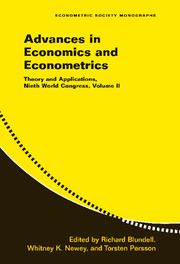Book contents
- Frontmatter
- Contents
- Contributors
- Introduction by the Editors
- Advances in Economics and Econometrics
- 1 Empirical Models of Auctions
- 2 Identification in Models of Oligopoly Entry
- 3 Empirical Models of Imperfect Competition: A Discussion
- 4 Recent Developments in the Economics of Price Discrimination
- 5 Bounded Rationality in Industrial Organization
- 6 Price Discrimination and Irrational Consumers: Discussion of Armstrong and Ellison
- 7 Behavioral Economics
- 8 Incentives and Self-Control
- 9 Discussion of “Behavioral Economics”
- 10 Dynamic Models for Policy Evaluation
- 11 Microeconometric Search-Matching Models and Matched Employer-Employee Data
- 12 Discussion of ‘Dynamic Models for Policy Evaluation’ and ‘Microeconometric Search-Matching Models and Matched Employer-Employee Data’
- 13 Field Experiments in Development Economics
- 14 Institutions and Development: A View from Below
- Index
- Titles in the series
2 - Identification in Models of Oligopoly Entry
Published online by Cambridge University Press: 05 January 2013
- Frontmatter
- Contents
- Contributors
- Introduction by the Editors
- Advances in Economics and Econometrics
- 1 Empirical Models of Auctions
- 2 Identification in Models of Oligopoly Entry
- 3 Empirical Models of Imperfect Competition: A Discussion
- 4 Recent Developments in the Economics of Price Discrimination
- 5 Bounded Rationality in Industrial Organization
- 6 Price Discrimination and Irrational Consumers: Discussion of Armstrong and Ellison
- 7 Behavioral Economics
- 8 Incentives and Self-Control
- 9 Discussion of “Behavioral Economics”
- 10 Dynamic Models for Policy Evaluation
- 11 Microeconometric Search-Matching Models and Matched Employer-Employee Data
- 12 Discussion of ‘Dynamic Models for Policy Evaluation’ and ‘Microeconometric Search-Matching Models and Matched Employer-Employee Data’
- 13 Field Experiments in Development Economics
- 14 Institutions and Development: A View from Below
- Index
- Titles in the series
Summary
Abstract
In the empirical study of markets, models of entry are often used to study the nature of firms' profits and the nature of competition between firms. Most of these estimated models have been parametric. In this paper, we review and extend a number of results on the identification of models that are used in the empirical literature.We study simple versions of both static and dynamic entry models. For simple static models, we show how natural shape restrictions can be used to identify competition effects. We consider extensions to models with heterogeneous firms, mixed-strategy equilibria and private information and provide insights that can be used in these settings to conduct inference. In the case of dynamic models, we review existing results on the model with i.i.d. linear errors, and then consider more realistic cases, such as when the distribution of fixed costs is unknown.
INTRODUCTION
In the empirical study of markets, models of entry are often used to study the nature of firms' profits and the nature of competition between firms. The idea of these models is that firms enter into a market only when they expect to operate profitably; therefore, entry decisions can be used as an indicator of a latent profit function.
The study of entry into oligopoly markets is complicated by strategic interactions between firms. This means that traditional ideas in the econometric literature on discrete choice models have to be modified somewhat to account for these strategic interactions.
- Type
- Chapter
- Information
- Advances in Economics and EconometricsTheory and Applications, Ninth World Congress, pp. 46 - 85Publisher: Cambridge University PressPrint publication year: 2006
- 49
- Cited by



